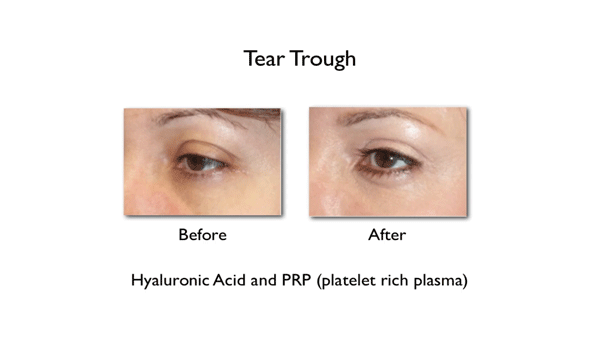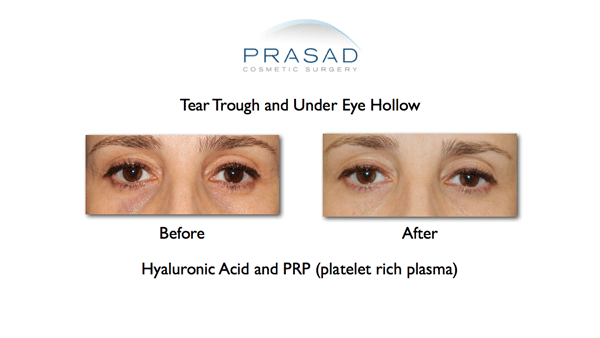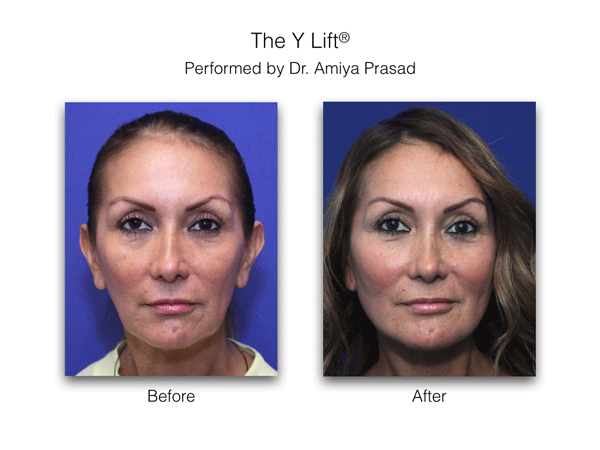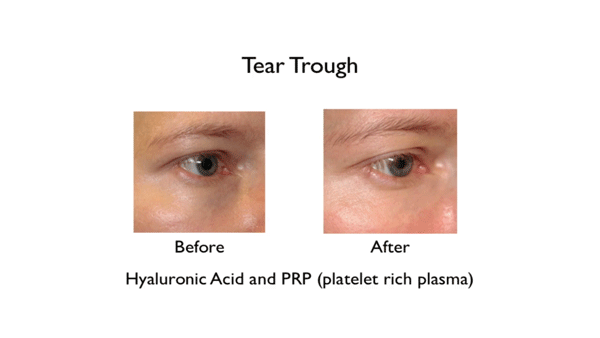Treatment of minimal under eye bags, under eye hollowness, and pronounced tear troughs can be done with the help of softer hyaluronic acid fillers.

Hollow under eyes and tear troughs are best addressed with softer hyaluronic acid fillers like Restylane or Juvederm Ultra, often combined with platelet-rich plasma (PRP) for improvement of eyelid skin discoloration and thickness
What causes under eye hollows?
Hollowness under the eyes can be limited to the tear trough area, or can encompass even the upper cheeks. There are number of causes for under eye hollowness, but the most common include genetics, volume loss due to aging, excessive sun exposure, and negative lifestyle factors such as smoking.
What is the best filler for under eye hollows?
Less viscous hyaluronic acid fillers such as Restylane, Restylane Silk, and Juvederm Ultra are typically recommended for treatment of under eye concerns due to delicate and thin lower eyelid skin, which measures only about 0.5mm in thickness. Dealing with such a complex area requires fillers that move flexibly and can be easily manipulated into the region, without profoundly changing the appearance of the low eyelid in the same manner that tear trough implants or thicker dermal fillers do.
Hyaluronic acid filler treatment can be quickly administered, and yields results that last anywhere from 3-6 months, depending on one’s metabolism. The material can be safely metabolized since hyaluronic acid occurs naturally in the body. Hyaluronic acid filler treatment is also reversible as the material can be dissolved with the help of hyaluronidase, an enzyme that dissolves it.
View tear trough filler before and after photos
Platelet-Rich Plasma (PRP) for Issues of Skin Pigmentation and Thickness
]Platelet-Rich Plasma (PRP) is separated and obtained after a patient’s own blood sample is spun in a centrifuge. PRP contains many healing and growth factors that aid in wound healing, and is known to improve circulation, stimulate the production of new collagen and the creation of new blood vessels. PRP is frequently used in Dr. Prasad’s practice to address issues with skin quality, texture, and pigmentation. In some cases, PRP can also be used in conjunction with fillers to prolong their effect, and act in synergy for skin quality improvement along with volume correction.

Volume correction in the tear troughs can be done using a combination of hyaluronic acid filler and PRP, which also helps improve skin texture, quality, thickness and extends the effects of the filler.
Why Fat Transfers Shouldn’t be Performed in Thin Eyelid Skin
When it comes to addressing lower eyelid hollowing, people often think that fat transfers are the better solution simply because of the fact that the fat is taken from their own body and is naturally-occurring. It is important to understand, however, that fat transfers are complex and unpredictable procedures.
Among the complexities of fat transfer procedures is the fact that (1) fat is texturally inconsistent, and can leave a lumpy and discolored appearance after being transferred, and easily seen through thin eyelid skin; (2) fat is easily and quickly reabsorbed by the body, where 30-70% fat can be absorbed, so fat transfer mostly involves at least two procedures; (3) fat requires a blood supply and may not take to one, which can lead to complications requiring complex surgical removal; and lastly (4) fat transfer procedures require several surgeries to complete — one for fat harvesting, and another for fat placement. Additional enhancements also require surgery to perform, and in the event of an undesirable result, surgery will also be needed to remove or correct it.
On the other hand, hyaluronic acid fillers yield immediate results without the need for surgery to place or remove the material.
Hollowing of the Under Eyes Can be Caused by Insufficient Cheek Volume
Under eye hollowing can be caused by a volume deficiency or difference in volume in the upper cheeks. This volume deficiency is usually a result of volume loss due to aging, or simply because of the natural asymmetry of the cheeks and face.
In Dr. Prasad’s practice, under eye hollowing due to insufficient cheek volume is addressed by injecting a thicker hyaluronic acid filler like Juvederm Ultra Plus or Juvederm Voluma into the cheeks by means of a procedure called Structural Volumizing, or the Y Lift® method. This method places a thicker, longer lasting hyaluronic acid filler such Juvederm Ultra Plus or Juvederm Voluma at a deeper level on top of the cheekbone, rather the soft tissue of traditional filler placement.

A volume deficiency in the cheeks can accentuate the appearance under eye hollowness, though can be treated with Structural Volumizing/ Y Lift® with natural-looking results.
Structural volumizing is a procedure that involves injecting filler into the deeper structural levels of the face, near the bone and under the muscle, with the purpose of achieving improved definition and angularity of the face. Injecting the filler deeper, as opposed to injecting it into the superficial layers of the skin, better addresses bone and volume loss due to aging, while avoiding that undesirable pillowy, doughy look. In addition to this, because thicker fillers are used, results tend to last longer — about 1-2 years.
Another procedure that is considered an option for cheek volume enhancement is fat transfer, as the thicker skin of the cheeks do not reveal the textural inconsistency of fat. However, fat transfer is still a unpredictable surgical procedure due to the body’s tendency to absorb a certain volume of fat, so additional fat transferring surgery is likely soon after the first.
Filler for Under Eye Bags
A common cosmetic concern among many younger people is how eye bags tend to make them look tired and older than they actually are. As such, many turn to fillers in the hope of correcting this, and the convenience and immediacy of results makes it one of today’s most popular and sought after cosmetic treatments. As eye bags are due to genetics rather than aging, it is commonly the first cosmetic surgical procedure considered by young people, and most at this age want to avoid surgery as they feel too young for it, or perceive it as costly, or do not want to risk surgery.
Does Fillers Work for Under Eye Bags?
A prevailing thought among many doctors is that fillers can treat all eye bags. In Dr. Prasad’s experience, however, this is not accurate. Fillers can address mild under eye bags, but severe bags with pronounced puffiness require a different treatment altogether.

Slight under eye bags can be camouflaged with filler injected into the transition between the hollow tear trough and the puffy eye bag.
Eye bags can become noticeable due to the hollowness of the tear trough area, thereby accentuating the puffiness in the adjacent areas. Think of it like how a valley situated next to a mountain accentuates the largeness of the mountain, and vice versa. Now, mild under eye bags and slight hollowness can be camouflaged by injecting filler into the tear trough area. However, placing filler into more severe eye bags often only make the puffiness look worse or exaggerated.
Thankfully, in situations wherein too much filler has been injected, hyaluronidase can be used to dissolve the unwanted material. Only when the original anatomy of the area has been restored can corrective treatment be done.
Correcting Volume Using Fillers After Eye Bag Surgery
At times there are cases wherein the surrounding areas will still look hollow, even after the fat pockets have been properly addressed with eye bag removal surgery. These surrounding areas usually include the upper cheeks and the junction between the eye and cheeks, which can be addressed with a thicker filler like Juvederm Voluma or Juvederm Ultra Plus; and the orbital rim and tear trough area, which do well with help from softer fillers like Restylane, Restylane Silk, or Juvederm Ultra.
Under Eye Bags: Fillers or Surgery?
Fillers for Short-Term Treatment but Needs Regular Maintenance
How long a filler lasts in the body depends on its viscosity. Thinner fillers usually last anywhere from 3-6 months, while thicker fillers can last for as long as 1-2 years. Because the primary ingredient in these fillers is hyaluronic acid, a substance that occurs naturally in the human body, how fast one’s body metabolizes the material also determines its longevity.
How Injectable Fillers and Eye Bag Surgery are Both Invasive Procedures
It’s important to understand that filler treatment is still considered an invasive treatment because you’re still piercing through the skin barrier with a needle. It’s ironic because many people opt for filler treatment instead of surgery because they want to avoid the invasiveness of surgery.
In many scenarios, however, surgery is better suited. In his practice, Dr. Prasad regularly employs the transconjunctival blepharoplasty method when addressing under eye bags. This procedure entails accessing the problematic fat pockets from the inside of the eyelids to reposition, sculpt, and remove the fat causing the bulge.
The transcutaneous blepharoplasty method involves making an external incision on the lower eyelid, through which the same procedure of sculpting or removing fat is done. The downside to this method is that it leaves a scar and is likely to damage the support structures of the lower eyelid, and result in complications such as eyelid retraction (pulled-down eyelids) and ectropion (everted lower eyelids).
Recovery Time: Fillers vs Under Eye Bag Surgery
Bruising, though temporary, is often to be expected after filler treatment, but rarely in Dr. Prasad’s practice. Interestingly, the recovery period for both a transconjunctival blepharoplasty and filler treatment takes about one week, however, what really sets a transconjunctival blepharoplasty apart is that one treatment session produces definitive results that can last for years, while fillers require repeated sessions in order to maintain its appearance. Dr. Prasad uses quick recovery methods for under eye surgery such as performing surgery with local anesthesia with LITE™ sedation, making recovery quick and convenient for the patient as opposed to general anesthesia.
If you’d like to consult with us regarding your cosmetic concerns, you may contact us by filling out the contact form below and we’ll get back to you. You may also reach out to our Manhattan, New York City offices at (212) 265-8877, and our Garden City, Long Island offices at (516) 742-4636.
